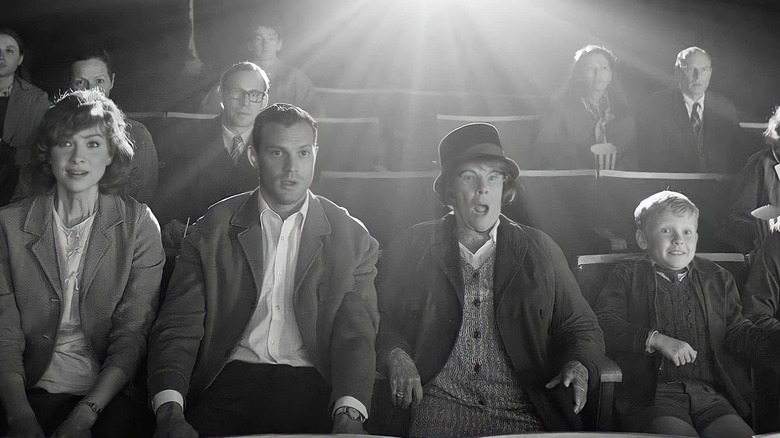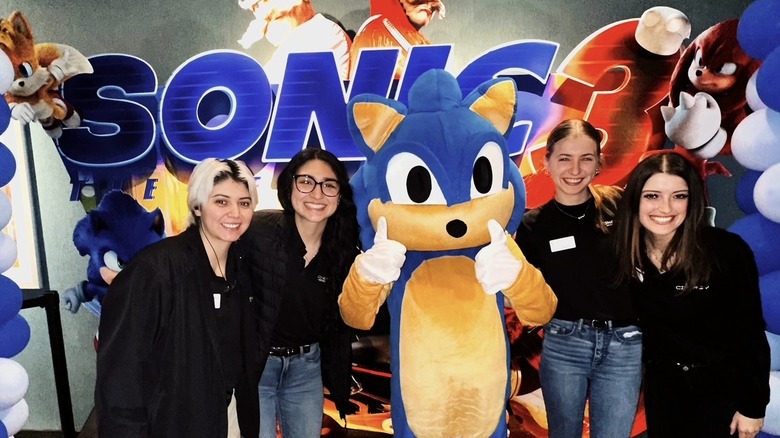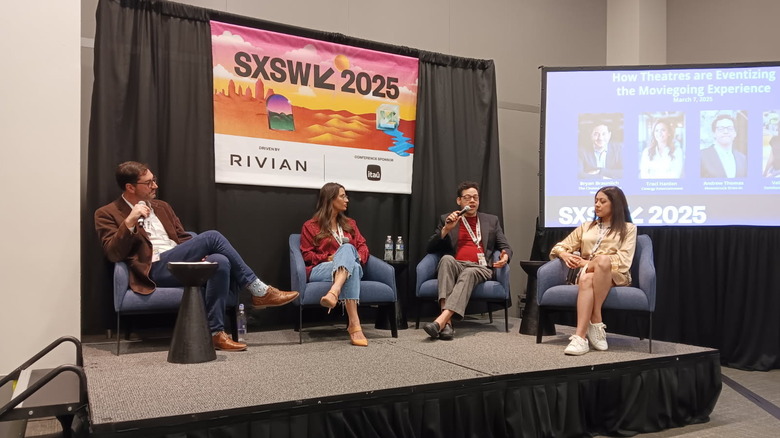What's The Future Of Movie Theaters? Bowling, Axe Throwing, And Yes, Movies
For the last handful of years, there has been some concern, both in the industry and from those who enjoy the cinematic experience, that movie theaters might be in some trouble. Ever since the pandemic forced theaters all around the world to close for months on end in 2020, things have been a little rocky. Yes, the box office has recovered quite a bit, but that recovery has been far slower than many expected. Fortunately, it does appear that moviegoing does have a future — it's just that the future will involve more than just movies. Axe throwing and a matinee, anyone?
During a panel at SXSW 2025 titled "How Theatres are Eventizing the Moviegoing Experience," we got a first-hand account from several people involved in the day-to-day of running regional theater chains explaining how things are changing. The biggest change of all? Going to the movies is largely no longer about just going to the movies. For the vast majority of prospective ticket buyers out there, gone are the days of simply going to a theater on a day ending in y just to see a movie and perhaps eat some popcorn.
Now, even that popcorn needs to come in a ridiculous, themed popcorn bucket. For many small chains, it's about making theaters part of larger family entertainment centers. Think Dave and Busters, but one where you can also go see a new Marvel movie. "With the family entertainment centers, what it's doing now, it's turning a trip to the movies to be one big outing," said Valarie Rico of the Texas-based Santikos Entertainment. "It's really turned into an all day hang out."
The future of movie theaters is so much more than movies
Traci Hanlon of Cinergy Entertainment also called it a "one-stop shop" these days. That means there are food offerings beyond the standard movie concessions at many of these places ... but that's just for starters. Many of these chains are now including bowling alleys, arcades, and yes, even axe throwing in some cases. "For 'Terrifier' or 'Heart Eyes,' we gave a bounce back so they could go throw axes after the movie," Hanlon revealed.
Welcome to the future of the movies.
Andrew Thomas of the Moonstruck Drive-In also spoke about how the drive-in is a unique experience that can offer something more unique than say an AMC or a Regal, which have both had their struggles in the pandemic era. "You get beautiful views of the skyline," Thomas said, while also explaining that their Houston location is in a place that is largely underserved by traditional movie theaters. Thomas has also worked to craft unique screening experiences, such as having Selena impersonators at screenings of "Selena" around the late singer's birthday.
All of the panelists expressed having lots of luck by doing themed events around older movies, with Santikos doing gangbusters business with "Twilight" screenings in recent years. Cinergy also does sensory friendly screenings once a month, which is free for families. They also all talked a lot about trying to build a community, which can help grow a loyal customer base.
It all comes back to the idea that a movie for a movie's sake isn't enough anymore. Much like pioneering fan-favorite chain the Alamo Drafthouse, which is now owned by Sony Pictures, all of these theaters offer dining experiences of some sort beyond traditional concessions. Santikos has one dine-in location, but they also have food pick-up lockers at the other locations for people who order food so they don't have to wait for people at the counter. "I know for my moviegoing experience, I plan it around meal time," Rico said.
Movie chains need to find creative ways to get people to leave the house
Dinner and a movie all in one is merely part of the strategy. All of these chains have also worked to craft experiences around big event movies, such as "Barbie" or "Wicked." From making themed cocktails to offering themed menu items, the recurring idea is that there has to be something extra. From bringing in cosplayers or utilizing local influences, it's about creating a social media-worthy experience. "Everybody wants to photograph it and post it," Hanlon said.
Whether or not cinema loyalists love the idea of having to pass through a bowling alley to get to their screening of "Oppenheimer" is somewhat irrelevant. The fact of the matter is that Netflix had greater revenue in 2024 than the entirety of the global box office. These businesses need to diversify in order to survive. So yeah, in some cases that involves offering innovations such as axe-throwing tied to a slasher film. "Adapt or die," as Billy Beane said in "Moneyball."
But what about premium formats such as IMAX and Dolby Cinema? Can't those help the bottom line? "The problem is, there aren't many Christopher Nolans," Thomas quipped. In the case of an "Oppenheimer," IMAX or even a 70mm print might make sense, but those things are expensive for a smaller theater and for the average Friday movie, moviegoers aren't wanting to spend that money. They'd rather get a cheaper ticket and hit up the arcade afterward.
Still, Thomas and the others were very optimistic about the future, in part because of these innovations, but also in part because the cinematic experience still means something. "What is your best memory of going to see a movie?" Thomas said of the question he asks when people ask if movie theaters are dying. They often have a detailed, specific answer. He then asks another question. "What is your greatest memory of streaming something at home?" The answers to that question are often less interesting.
"No one really remembers anything about the experience," Thomas said. "I don't usually see people take selfies on their couch to post about the movie they're streaming."


